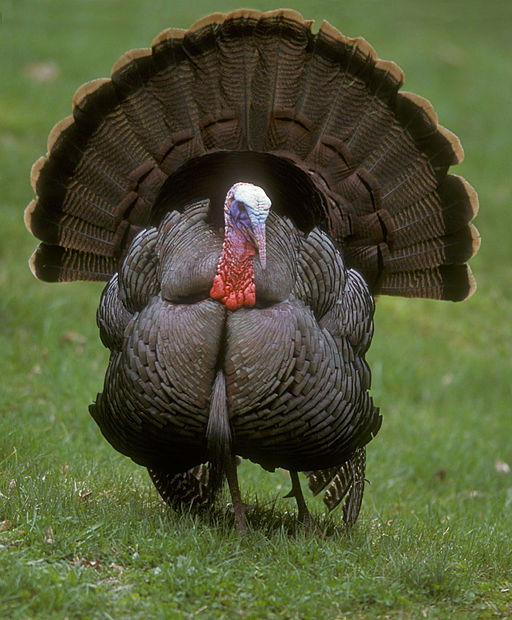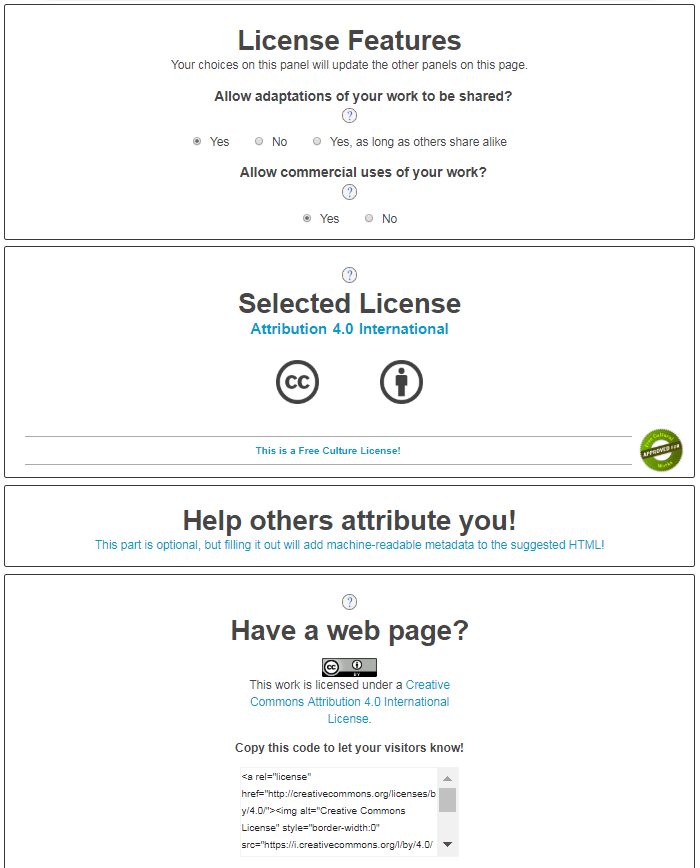5 Week 5 Lecture Notes: Using Creative Commons
These lecture notes adapted from Creative Commons Certificate for Educators and Librarians and are used under a CC BY 4.0 License.
Finding Creative Commons Licensed Works
Recall from last week that the Creative Commons licenses have three layers: a “human readable” or easy to read layer, a layer made up of the technical legal jargon, and a machine-readable layer. The machine readable layer is what makes it easy to find Creative Commons licensed works. You can use the advanced search features of most search engines to limit your search results only to materials licensed with Creative Commons licenses.
In Google, use the Google Advance Search Page, scroll all the way to the bottom and look for the Usage Rights drop down menu. Notice how the options there closely resemble the different Creative Commons license options. Google will also include public domain materials in your results when you limit your search to openly licensed materials.
In Google Images once you have already done a search, you can click on the Tools button to view a set of drop down menus. Again, look for the Usage Rights drop down menu.
There are quite a few platforms that have Creative Commons enabled search features, including:

In addition to the resources and strategies above, here are some other websites that can be used to find openly licensed content, public domain works, or both:
- Flickr (images, use the license dropdown menu to limit to Creative Commons)
- Unsplash (images)
- The Noun Project (icons)
- Wikimedia commons (many formats)
- Wellcome Image Collection (images, mainly anthropology and science)
- ccMixter (audio)
- Free Music Archive (audio)
- Jamendo (audio)
- MusOpen (audio, sheet music, texts)
- Moving Image Archive (video)
- Creative Commons on Vimeo (video)
- Open Video Project (video, mostly educational)
- Public Domain Project (audio, video, images)
- Public Domain Review (images, texts, video, audio)
- Project Gutenberg (public domain texts)
- Directory of Open Access Journals (scholarly publishing)
Creative Commons Attribution
When you find a CC work you want to reuse, the single most important thing to know is how to provide attribution. All CC licenses require that attribution be given to the creator. The elements of attribution are simple, though generally speaking, the more information you can provide, the better. People like to understand where CC licensed works come from, and creators like to know their names will remain attached to their works. If an author has provided extensive information in their attribution notice, retain it where possible.
The best attributions contain the following information:
- Title of the work: Not all works are titled, but if they are, do include this information.
- Link to the original work: Driving traffic to the original, and helping others find it is a way of paying back the creator who is allowing their work to be used.
- Author/Creator’s name: This information is not available for all works, and sometimes the only information available is a screen name. Whatever information is available, include it.
- License of the original work: State the license that the creator has shared their work under
- Link to the license: Include the hyperlink to the Creative Commons deed (the human readable layer of the license.)
So for example, let’s say I want to properly attribute this image:
 I found this image on Flickr.com at https://flic.kr/p/29EiNY, and to find the attribution information I had to look around the screen and even had to follow some links (for example on Flickr, you have to click “Some Rights Reserved” to find out which CC license is being used.) This is likely true whatever platform you use to find your CC licensed works. The information I would need for a good attribution to this image is:
I found this image on Flickr.com at https://flic.kr/p/29EiNY, and to find the attribution information I had to look around the screen and even had to follow some links (for example on Flickr, you have to click “Some Rights Reserved” to find out which CC license is being used.) This is likely true whatever platform you use to find your CC licensed works. The information I would need for a good attribution to this image is:
- Title of the work: This work is not titled.
- Link to the original work: https://flic.kr/p/29EiNY
- Author/Creator’s name: Jay OHare
- License of the original work: CC BY-NC
- Link to the license: https://creativecommons.org/licenses/by-nc/2.0/
My preferred way of formatting an attribution is like this:

Image by Jay OHare is licensed under CC BY-NC.
This work didn’t have a title, so I used the word “Image” and I put the hyperlink to the original on this word. I also put the hyperlink for the Creative Commons deed on the name of the license, “CC BY-NC.” This helps keep the attributions shorter and neater, while providing all the necessary information.
This is just my preferred method for providing attribution, the attribution requirements in the CC licenses are purposefully designed to be fairly flexible to account for the many ways content is used. A filmmaker will have different options for giving credit than a scientist publishing an academic paper. Take some time to explore this page about Best Practices for Attribution on the CC wiki.
If your work is a modification or adaptation of another work, you should indicate this along with the other attribution information. For example, if I cropped the photo above, my attribution might look like this:

Image by Jay OHare is licensed under CC BY-NC, cropped from original.
What I’ve described above are the best practices for providing attribution for Creative Commons licensed works, but to avoid plagiarism, all work (even ideas) that you reuse from others should be properly attributed. Probably by now you have had to use either APA, MLA, or Chicago citation styles in your other classes. These are just other systems for providing attributions. Those are the attribution systems commonly used in academic work, whereas what I’ve described above is an attribution system that is suited for more informal work done on the internet. From here on out in this class I will be looking for you to attribute all images that you use in your work. You are welcome to use the system above or any of the more formal citation systems (APA, MLA, or Chicago).
Copyright Infringement vs Plagiarism
There is a lot of confusion around the difference between copyright infringement and plagiarism. Copyright infringement refers to a situation where someone has exercised one of the four monopoly rights (copying, distribution, adaptation, or performance/display) without the permission of the copyright holder (or without a good fair use argument.) Plagiarism refers to the reuse of someone else’s ideas, sequence of arguments, or word for word copying without attributing these to the original author. There are many differences:
- Copyright is a violation of a law and is illegal, whereas plagiarism is not illegal (in the United States at least, it is illegal in many other countries.)
- Copyright does not apply to ideas (only to the expressions of ideas) but it is completely possible to plagiarize an idea.
Plagiarism is taken very seriously in academia (more so that copyright infringement.) In academia, if you do not attribute the source of an idea or text, you are representing that it is your own and the penalties for this can be severe.
It is possible for an action to constitute both plagiarism and infringement, and it is possible for an action to be one but not the other:
- A student copies a few pages from a copyrighted book and hands it in as part of an assignment for a class without citing the book. This is both plagiarism and infringement.
- A student copies a few pages from a public domain book and hands it in as part of an assignment for a class without citing the book. This is plagiarism, but not infringement.
- A student photocopies a textbook and shares these with other students in the class so they don’t have to buy the book. This is infringement, but not plagiarism.
Even though there is no legal requirement to provide attribution to a public domain work, within academia there is an expectation that all ideas, text, images, etc. are attributed to their original creators. Even if you use a public domain image, you should provide attribution:

Image by Riki7 is in the public domain.
Applying a Creative Commons License to Your Work
If you’ve decided you want to use a CC license on your own work, you can use the Creative Commons License Chooser to identify the license that is right for you. After you select the boxes that indicate your preferences, the chooser generates the appropriate license based on your selections. Take some time to play around with the CC license chooser now. Remember, the license chooser is not a registration page, it simply provides you with standardized HTML code, icons and license statements.
Do you see the text and icon just above the code? That text and links can also be copied and pasted onto your work to mark the work with a CC license. If you want to mark the work in a different way or need to use a different format like closing titles in a video, you can visit https://creativecommons.org/about/downloads/ and access downloadable versions of all of the CC icons.
Applying the license is simple: technically, all you have to do is indicate which CC license you are applying to your work and include a link (or write out the CC licence URL, if you are working offline) to the relevant CC license deed. You can do this in the title page, title slide, on the footer of your website, or any other place that makes sense in light of the particular format and medium of your work. The important thing is to make it clear what the CC license covers and locate the notice in a place that makes that clear to the public. For more examples of how to mark your own work in different contexts, spend some time looking through CC’s extensive marking page.
If you are on a platform like Medium or Flickr, you should use the built-in CC license tools on the platform to mark your work with the CC license you choose. Even YouTube has a built in CC license (although they only let you choose CC BY.)
Can I Charge for My Creative Commons Licensed Work?
If you think that you might want to charge for certain uses of your work, the Creative Commons Attribution Non-Commercial License could be a good option for you. This would grant anyone using your work for personal use or other non-commercial activities a set of permissions, while leaving you the latitude to enter into licensing agreements for commercial uses. As the creator, selling your work is always okay, even if you have put a CC BY-NC license on the work. In fact, selling physical copies (e.g., a textbook) and providing the digital copies for free is a very common method for making money while using CC licenses.
Here is a prominent example from CC’s Team Open feature: Max Temkin, founder of Cards Against Humanity:

Stack of Cards Against Humanity packs by jareed used under CC BY 2.0.
Charging for access to digital copies of a CC licensed work is more difficult. It is permissible, but once someone pays for a copy of your work, she can legally distribute it to others for free under the terms of the applicable CC license.



